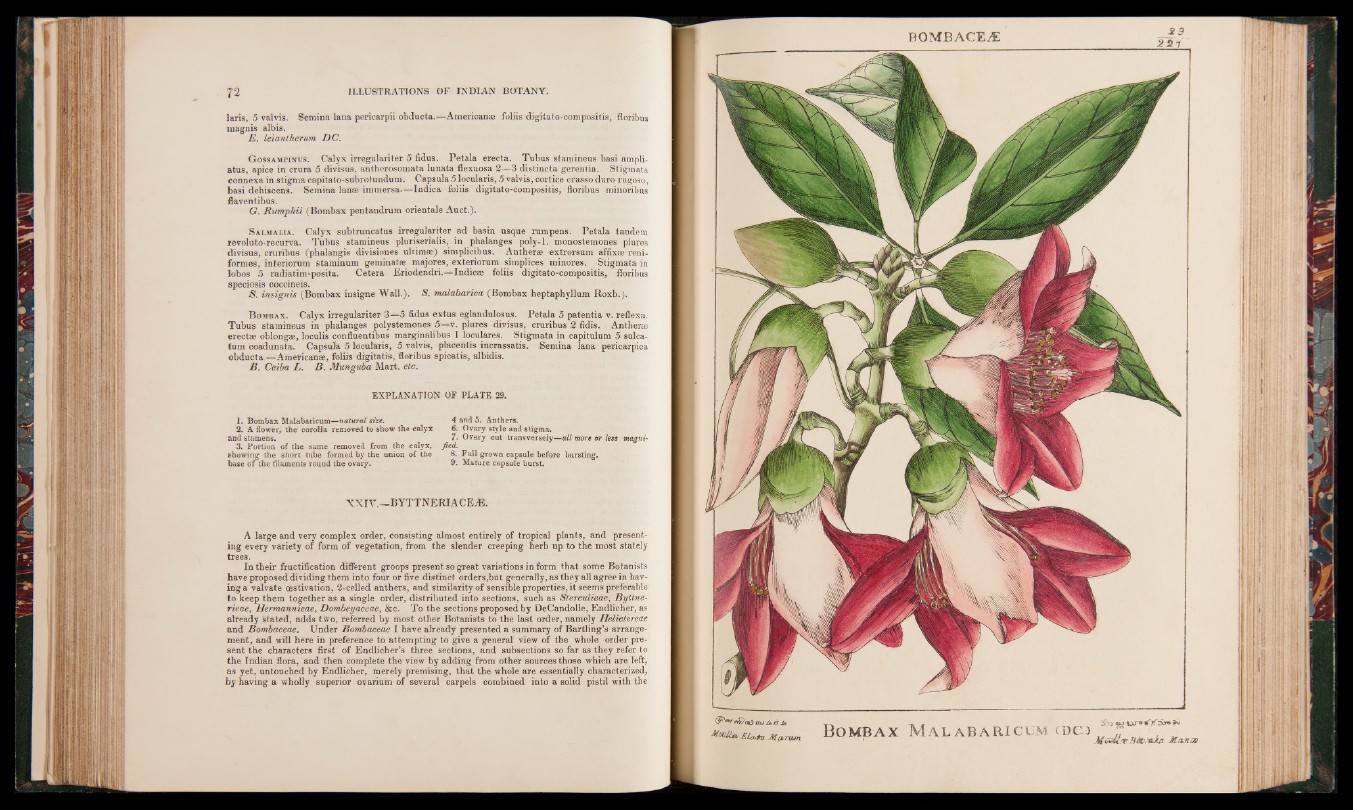
laris, 5 valvis. Semina 1-ana pericarpii obducta.—American® foliis digitato-compositis, floribus
magnis albis.
E. leiantherum DC.
G ossampinus. Calyx irregulariter 5 fidus. Petala erecta. Tubus stamineus basi ampli-
atus, apice in crura 5 divisus, antherosomata lunata flexuosa 2—3 distincta gerenfia. Stigmata
connexa in stigma capitato-subrotundum. Capsula 5 locular is J 5 valvis, cortice crasso duro rugoso,
basi dehiscens. Semina lanse immersa.—Indica foliis digitato-compositis, floribus minoribus
flaventibus.
G. Rumphii (Bombax pentandrum orientale Auct.).
Salmalia. Calyx subtruncatus irregulariter ad basin usque rum pens. Petala tandem
revoluto-recurva. Tubus stamineus pluriserialis, in phalanges poly-1, monostemones plures
divisus, cruribus (phalangis divisiones ultimae) simplicibus. Anther® extrorsum affixae reni-
formes, interiorum staminum geminat® majores, exteriorum simplices minores. Stigmata in
lobos 5 radiatim-posita. Cetera Eriodendri.—Indie® foliis digitato-compositis, floribus
speciosis coccineis.
&. insignis (Bombax insigne Wall.). S. malabarica (Bombax heptaphyllum Roxb.).
B ombax. Calyx irregulariter 3—5 fidus extus eglandulosus. Petala 5 patentia v. reflexa.
Tubus stamineus in phalanges polystemones 5—v. plures divisus, cruribus 2 fidis. Anther®
erect® oblong®, loculis confluentibus marginalibus 1 loculares. Stigmata in capitulum 5 sulcatum
coadunata. Capsula 5 locul'aris, 5 valvis, placentis incrassatis. Semina lana pericarpica
obducta. -^American®, foliis digitatis, floribus spicatis, albidis.
B. Ceiba L. B. Munguba Mart. etc.
EXPLANATION OF PLATE 29.
1. Bombax Malabaricum—natural size.
2. A flower, the coroîl'a removed to show the calyx
and stamens.
3. Portion of the same removed from the calyx,
showing the short tube formed by the union of the
base of the filaments round the ovary.
4 and’ 5. Anthers.
6. Ovary style and stigma-.
7. Ovary eut transversely—all more or less magnified.
8. Full grown capsule before bursting.
9. Mature capsule butst.
XXIV.—BYTTNERIACEÆ.
A large and very complex order, consisting almost entirely of tropical plants, and presenting
every variety of form of vegetation, from the slender creeping herb up to the most stately
trees.
In their fructification different groops present so great variations in form that some Botanists
have proposed dividing them into four or five distinct orders,but generally, as they all agree in having
a valvate aestivation, 2-celled anthers, and similarity of sensible properties, it seems preferable
to keep them together as a single order, distributed into sections, such as Sterculieae, Byttne-
rieae, Hermannieae, Dombeyaceae, See. To the sections proposed by DeCandolle, Endlicher, as
already stated, adds two, referred by most other Botanists to the last order, namely Helictereae
and Bombaceae. Under Bombaceae I have already presented a summary of Bartling’s arrangement,
and will here in preference to attempting to give a general view of the whole order present
the characters first of Endlicher’s three sections, and subsections so far as they refer to
the Indian flora, and then complete the view by adding from other sources those which are left,
as yet, untouched by Endlicher, merely premising, that the whole are essentially characterized,
by having a wholly superior ovarium of several carpels combined into a solid pistil with the
B OMB A C EÆ 2 9
2 2 1
UttJb
to-dollm jEloAfa. M aui wn B o m b a x M a l a b a r i c u m c o o , ? . ^
1 . M f H è w 1fa«